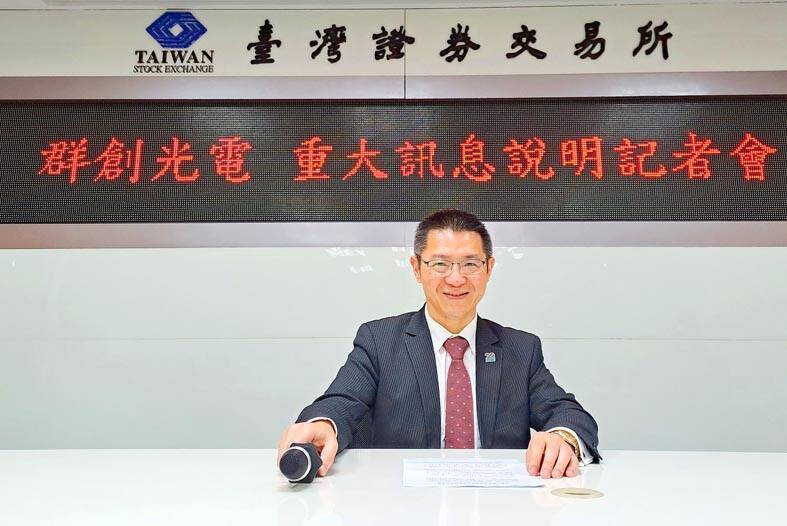Flat-panel maker Innolux Corp (群創) yesterday said its losses narrowed to NT$7.77 billion (US$254.5 million) last quarter from the prior quarter’s NT$12.39 billion, thanks to an unusual uptick in average selling prices (ASP) during the industry’s slow season.
Blended ASP climbed to US$240 per square meter, from US$235 in the prior quarter, the company said in a statement.
Innolux had expected prices to remain steady last quarter.

Photo: CNA
Gross margin improved to minus-7 percent last quarter, from minus-15 percent in the previous quarter.
Innolux expects the price uptrend to carry into the current quarter, benefiting from improving inventory buildup ahead of a shopping festival in China in June.
Panel shipments are expected to increase this quarter, Innolux said, adding that demand would continue improving from the second quarter.
The company also expects TV panel prices to climb further this quarter, while prices of some panels used in monitors would see a modest rebound, as customers’ inventory depletion is coming to an end.
Improving demand is expected to drive up blended ASP by about 5 percent this quarter from the previous quarter, the company said.
Shipments of TV, computer and monitor panels are to expand 12 to 13 percent sequentially this quarter, while those of small and medium panels would likely grow 12 to 13 percent, it said.
Separately, Innolux chairman Jim Hung (洪進揚) said the company’s board of directors has approved a 5 percent capital reduction in cash to enhance shareholders’ return on equity and to improve the company’s capital structure.
Shareholders would receive a payback of NT$0.5 per common share after the share cancelation, Hung told a news conference at the Taiwan Stock Exchange yesterday.
Innoloux’s capital would decline to NT$90.79 billion following the capital reduction, he said.
The capital reduction proposal is subject to approval by shareholders during the annual shareholder’s meeting on May 31.
Innolux also decided not to distribute dividends this year after reporting a loss of NT$27.99 billion for last year, its first annual loss in about a decade, amid an industry slump caused by oversupply, Hung said.

The US dollar was trading at NT$29.7 at 10am today on the Taipei Foreign Exchange, as the New Taiwan dollar gained NT$1.364 from the previous close last week. The NT dollar continued to rise today, after surging 3.07 percent on Friday. After opening at NT$30.91, the NT dollar gained more than NT$1 in just 15 minutes, briefly passing the NT$30 mark. Before the US Department of the Treasury's semi-annual currency report came out, expectations that the NT dollar would keep rising were already building. The NT dollar on Friday closed at NT$31.064, up by NT$0.953 — a 3.07 percent single-day gain. Today,

‘SHORT TERM’: The local currency would likely remain strong in the near term, driven by anticipated US trade pressure, capital inflows and expectations of a US Fed rate cut The US dollar is expected to fall below NT$30 in the near term, as traders anticipate increased pressure from Washington for Taiwan to allow the New Taiwan dollar to appreciate, Cathay United Bank (國泰世華銀行) chief economist Lin Chi-chao (林啟超) said. Following a sharp drop in the greenback against the NT dollar on Friday, Lin told the Central News Agency that the local currency is likely to remain strong in the short term, driven in part by market psychology surrounding anticipated US policy pressure. On Friday, the US dollar fell NT$0.953, or 3.07 percent, closing at NT$31.064 — its lowest level since Jan.

Hong Kong authorities ramped up sales of the local dollar as the greenback’s slide threatened the foreign-exchange peg. The Hong Kong Monetary Authority (HKMA) sold a record HK$60.5 billion (US$7.8 billion) of the city’s currency, according to an alert sent on its Bloomberg page yesterday in Asia, after it tested the upper end of its trading band. That added to the HK$56.1 billion of sales versus the greenback since Friday. The rapid intervention signals efforts from the city’s authorities to limit the local currency’s moves within its HK$7.75 to HK$7.85 per US dollar trading band. Heavy sales of the local dollar by

The Financial Supervisory Commission (FSC) yesterday met with some of the nation’s largest insurance companies as a skyrocketing New Taiwan dollar piles pressure on their hundreds of billions of dollars in US bond investments. The commission has asked some life insurance firms, among the biggest Asian holders of US debt, to discuss how the rapidly strengthening NT dollar has impacted their operations, people familiar with the matter said. The meeting took place as the NT dollar jumped as much as 5 percent yesterday, its biggest intraday gain in more than three decades. The local currency surged as exporters rushed to